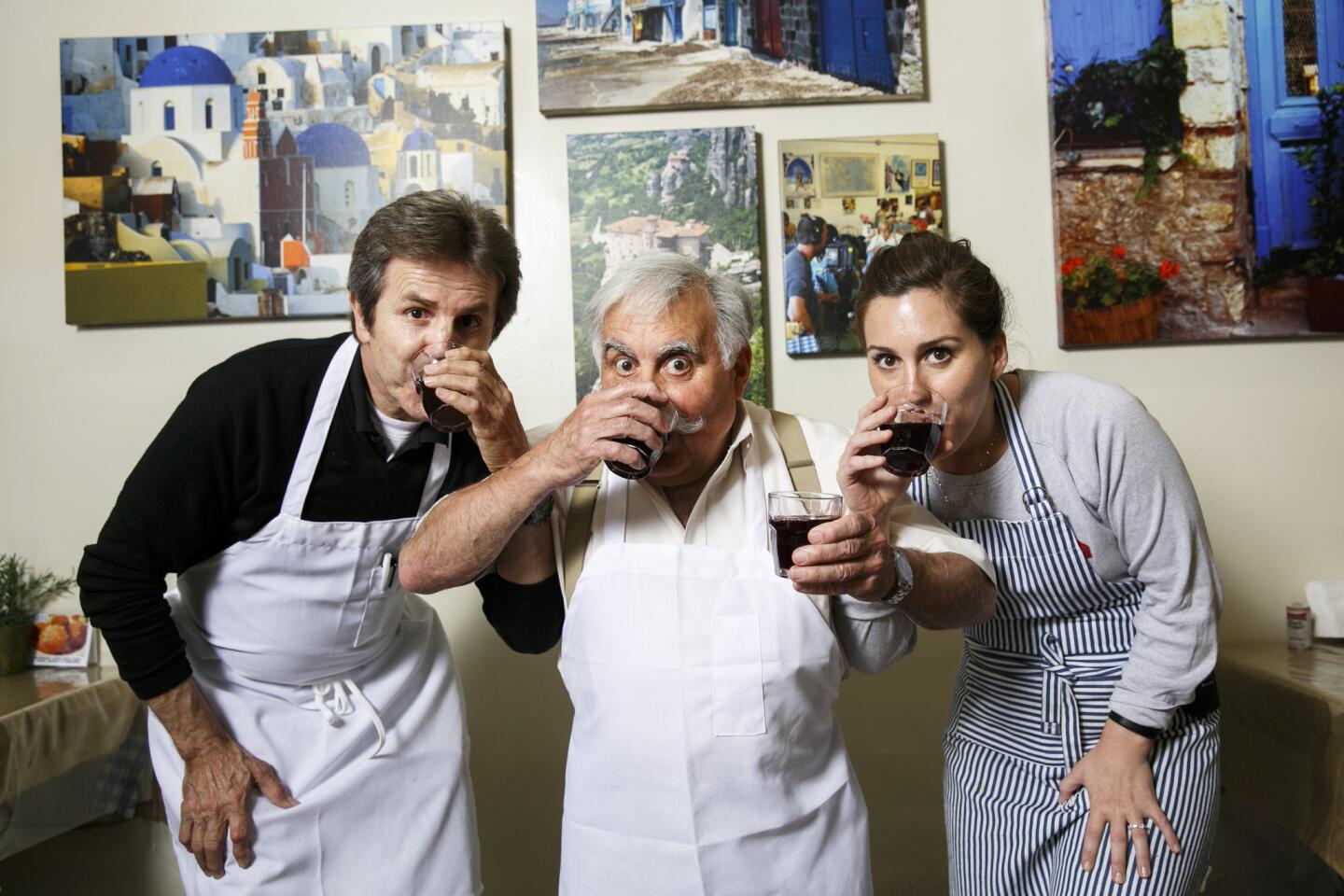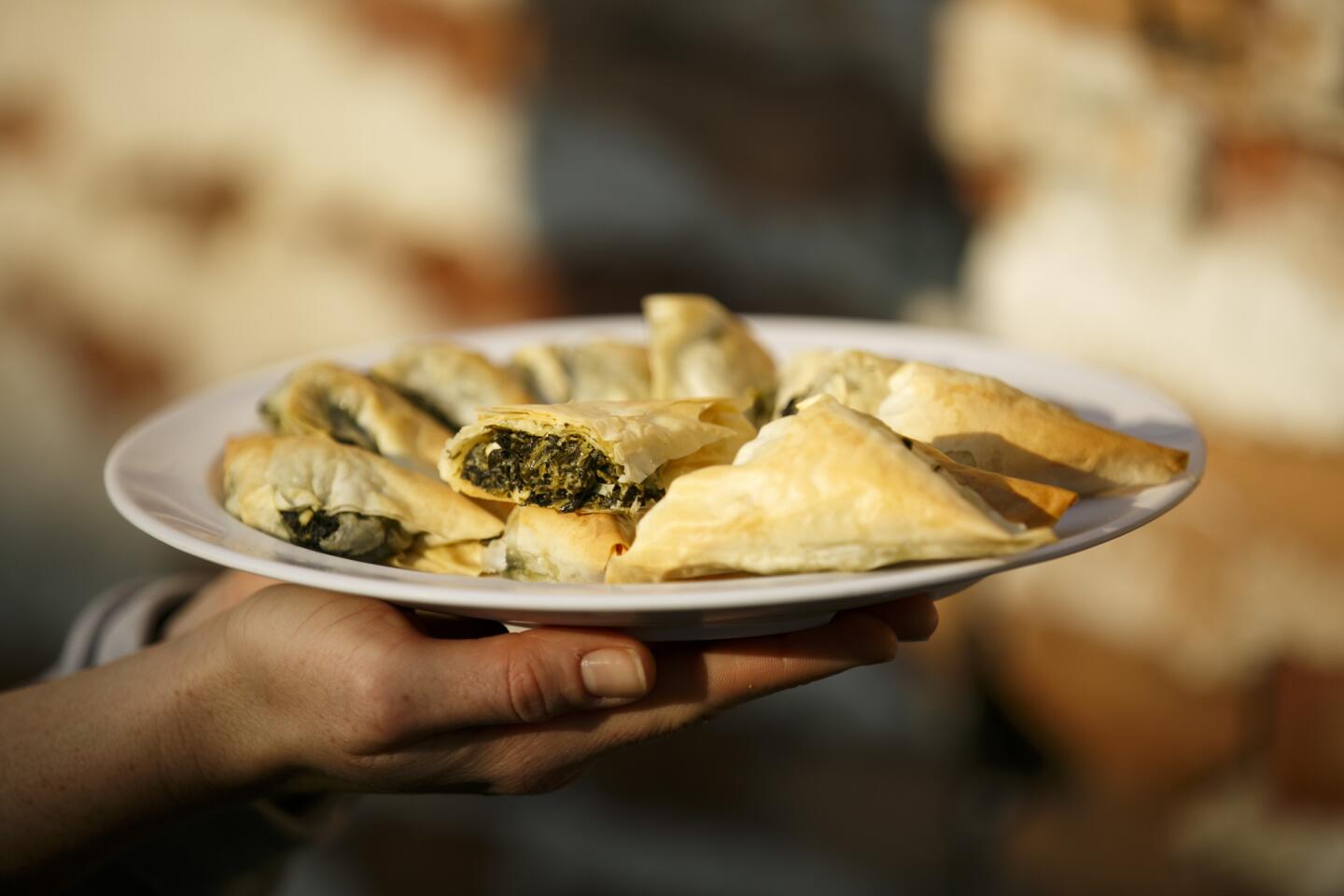Papa Cristo’s cooks up a new reason to visit: free Greek cooking classes
- Share via
For 68 years, Papa Cristo’s Greek restaurant and shop has helmed a dense stretch of Pico Boulevard in the Pico-Union neighborhood of Los Angeles. These days, the area is populated with carnicerias, dollar stores and — crucial to Papa Cristo’s history — St. Sophia Greek Orthodox Cathedral across the street. For decades, the ornate cathedral and shop shared a mostly Greek clientele; nowadays, Papa Cristo’s draws people from as many backgrounds as fill the city.
Inside Papa Cristo’s nearly block-wide storefront, amid the labyrinthine shingled roofs, shelves and barrel-topped display tables, you’ll find not only jars of marinated olives, bunches of fresh dried oregano, bricks of pistachio-flecked sesame halvah and many other Greek spices and staples, but also discs of Ethiopian injera, boxes of Italian panettone and 10-pound bags of Indian basmati rice.
“We’re like the United Nations,” second-generation Papa Cristo’s owner Chrys Chrys says of his customers. To the right of the rambling shop is an open taverna kitchen where lamb souvlakia or fresh calamari sizzle between flames on the large grill. Kitchen staff in white aprons take orders from the counter wedged in front. Past the kitchen, to the left of the eclectic shop, is a large dining room where people seat themselves and eat off paper plates amid wall hangings of iconic images of Greece — reproductions of ancient art and columned architecture as well as large photographs of contemporary chalky white stucco buildings and the bright blue Aegean Sea. There are also smaller black-and-white photographs of the Chrys family and the shop through the decades.

Recipe: Papa Cristo’s moussaka
Chrys Chrys’ father, Sam, immigrated to the United States in 1914 and opened the shop selling imported Greek goods in 1948; in 1985, Chrys Chrys expanded the business by creating the kitchen and dining room as “wings,” as he calls them, to the shop. But other than that, Chrys did little to change the integrity of his father’s original storefront. A large painted portrait of Sam Chrys still hangs over the long row of refrigerated display cases.
What has changed is the community. Inspired by the desire to serve their clientele — and attract newcomers — Chrys and his daughter, Annie, who helps run the business, recently began offering free cooking classes, held once or twice a month in the large industrial kitchen behind the shop’s floor.
“We thought, ‘How can we create something for our community?’” Annie Chrys says, “Before, there were a lot more Greeks in the area — 20, 50 years ago — and they didn’t need to learn from us. But now our neighborhood has changed so much, some people may not know how to incorporate feta cheese or kalamata olives in their everyday cooking.”

Recipe: Papa Cristo’s spanakopita
Her father puts it a little different. From behind his white handlebar mustache, he says: “A good recipe is like a good old bottle of wine: You should share it with somebody. Don’t just sit there and drink it by yourself — that’s no fun.” The idea of charging for the classes seemed antithetical to how Chrys sees the world. “You go to a Greek’s house, the first thing you get is something stuck in your mouth and a drink in your hand.”
It’s no surprise, then, that classes begin with plastic mini tumblers of house red wine and small cubes of fresh imported Greek feta.
Chrys teaches the classes, which began in February, with the help of cooks Renata Romano and Apolonia Jimenez. Both have been working for the restaurant since coming to Los Angeles from Mexico nearly two decades ago; today they’re experts in Greek cuisine. As Jimenez quickly folds and tucks the phyllo dough around the spinach and cheese filling, Mark Yordon, manager of Papa Cristo’s and a Chrys family cousin, says: “It’s like folding the American flag.” It’s an apt metaphor.
Besides spanakopita, participants in the hour-long class might learn the secrets to moussaka, how to prepare a leg of lamb or the precise proportions of paper-thin phyllo dough to cinnamon-sweet nut filling for baklava. Items such as these, all made by hand on the premises, are also sold wholesale to national grocery stores and even cruise lines.
Some recipes shared during the classes have been in the Chrys family for generations. Others are slightly newer iterations that Chrys has created over the years. The kataifi rolls, for example, are his invention, with a layer of shredded phyllo dough wrapped around the standard whole sheet phyllo before being drizzled with a golden syrup flavored with curls of lemon rind and whole cinnamon sticks.
“The only way I can share is by teaching,” Chrys says. “I want to be a village restaurant.”
Papa Cristo’s: 2771 W. Pico Blvd., Los Angeles, (323) 737-2970, papacristos.com. The next Greek cooking classes are scheduled for 6:30 p.m. May 11 and May 25 There’s no charge, but advance registration is required. For more information, email: papacristoscooking@gmail.com.
More to Read
Eat your way across L.A.
Get our weekly Tasting Notes newsletter for reviews, news and more.
You may occasionally receive promotional content from the Los Angeles Times.
















